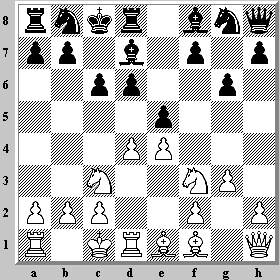In chess960, the castling pieces move to the same squares as in SP518, but there are four distinct ways the two pieces can be moved:-
- by moving both the King and the castling Rook to new squares (as in SP518);
- by switching the King and the castling Rook on their squares;
- by moving only the castling Rook; and
- by moving only the King.
An instructive example of the third case happened in 2009 at Chess Classic Mainz (see CCM9: Nakamura, Grischuk, and Rybka for more about the event). The first third game of the final match between between defending champion GM Aronian and his challenger GM Nakamura started with SP666: RNKRBBNQ. After five moves, the players reached the following position.
Mainz 2009, Final Match, Game 1 3
Aronian, Levon
Nakamura, Hikaru
(After 5...Be8-d7)
[FEN "rnkr1bnq/pp1b1p1p/2pp2p1/4p3/3PP3/2N2NP1/PPP2P1P/R1KRBB1Q w DAda - 0 6"]
At this point, both players had probably already decided to castle O-O-O. This can eventually be done by hopping the Rook on the a-file over the King, but there is a small problem to be solved: the Rook on the d-file blocks the castling move and must be moved first. (The Black Knight on b8 must also move, but this isn't the focus of the current discussion.)
Nakamura played 6.Rd3. This move looks unusual until we recognize that its purpose is to free the d1-square for castling O-O-O. The game continued 6...Na6 (developing the Knight, which is also necessary for ...O-O-O) 7.a3 Bh6+ 8.Bd2 Bg7 9.Be3 exd4 10.Bxd4 Nc5 11.Rd2 Nf6 12.Ng5. White attacks Black's f-Pawn, while threatening a nasty fork on f7. Aronian solved both problems with 15...Rf8, a move which finally prepares ...O-O-O by clearing d8. Now both players whisked their respective Kings into safety with 13.O-O-O O-O-O.
The full score of the game, courtesy of Chess Tigers, is
[Event "CCM9 - Chess960 Rapid WCh"]
[Site "Mainz"]
[Date "2009.07.30"]
[Round "9.1"]
[White "Nakamura, Hikaru"]
[Black "Aronian, Levon"]
[Result "1-0"]
[SetUp "1"]
[FEN "rnkrbbnq/pppppppp/8/8/8/8/PPPPPPPP/RNKRBBNQ w DAda - 0 1"]1.e4 e5 2.Nf3 g6 3.Nc3 c6 4.g3 d6 5.d4 Bd7 6.Rd3 Na6 7.a3 Bh6+ 8.Bd2 Bg7 9.Be3 exd4 10.Bxd4 Nc5 11.Rd2 Nf6 12.Ng5 Rf8 13.O-O-O O-O-O 14.e5 Ng4 15.f4 Ne6 16.Nxe6 Bxe6 17.h3 dxe5 18.Bxa7 Nf6 19.Ba6 e4 20.Qg1 Rxd2 21. Bxb7+ Kxb7 22.Qb6+ 1-0
This quick win in the first game set Nakamura on the path to winning the match in the third game gave Nakamura an insurmountable lead in the match.
***
Later: I don't what I was thinking when I wrote this. It was the third game, not the first!

No comments:
Post a Comment